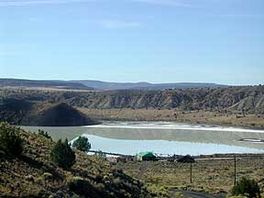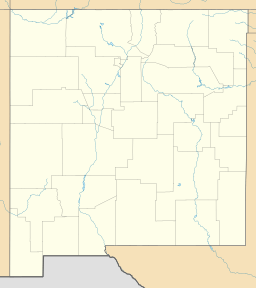Zuni Salt Lake facts for kids
Quick facts for kids Zuni Salt Lake |
|
|---|---|

c. 2000
|
|
| Location | Catron County, New Mexico, United States |
| Coordinates | 34°27.0′N 108°46.1′W / 34.4500°N 108.7683°W |
| Type | Maar |
| Primary outflows | Evaporation |
| Basin countries | United States |
| Surface elevation | 6,224 ft (1,897 m) |
Zuni Salt Lake, also called Zuñi Salt Lake, is a special lake in the desert. It is found in Catron County, New Mexico, USA. This lake is a "maar", which means it formed in a volcanic crater. It is about 60 miles south of the Zuni Pueblo.
The lake is very shallow, only about four feet deep when it is wet. But when the weather gets dry, much of the water disappears. This leaves behind flat areas covered in salt, called saltflats. Because it is so unique and important, Zuni Salt Lake was added to the National Register of Historic Places in 1999. It is also part of the Red Hill volcanic field.
Contents
History of Zuni Salt Lake
For hundreds of years, the Pueblo people of the Southwest have visited Zuni Salt Lake. Groups like the Zuni, Acoma, Laguna, Hopi, and Taos pueblos made yearly trips. They collected salt from the lake for cooking and for important ceremonies.
Sacred Lake and Ancient Roads
Old roads spread out from the lake, leading to different pueblo villages. Some of these roads even connect to ancient sites like Chaco. The lake itself is considered a very sacred place. The Zuni people believe it is home to the Salt Mother deity, who they call Ma'l Okyattsik'i. Early Hispanic settlers in the area also knew the lake as Las Salinas.
Geronimo's Story
The famous Apache leader Geronimo wrote about the lake in his book, Geronimo's Story of His Life. He said that his people got their salt from a small lake in the Gila Mountains. He also mentioned that when visiting this lake, people were not allowed to hunt animals or fight enemies. Everyone and everything was safe there.
Returning the Land to Zuni Control
Zuni Salt Lake was not originally part of the land set aside for the Zuni people by the U.S. government. However, in 1985, the U.S. government returned the lake and about 5,000 acres of land around it to Zuni control. This was an important step in recognizing the lake's significance to the Zuni people.



